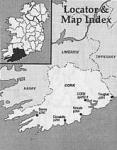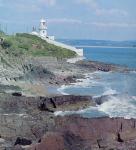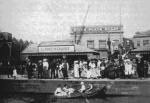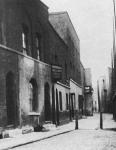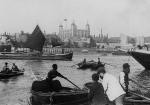Mabel Victoria Day (1897 - 1943)
Mary Eliza HAMMETT
Mary Eliza brings an Irish element into the genetic mix. Baptised the 25th July 1852 in the Church of Ireland in Youghal, County Cork, Mary Eliza was the daughter and only child of John HAMMETT and his second wife, Elizabeth HANAN. John, whose occupation was variously cordwainer (=shoemaker), Clerk of the Chapel of Ease (=sexton) and, latterly, Customs Officer, had previously been married to a Dorothea with whom he had two daughters, Elizabeth, born and baptised in March 1845, and Maria, born and baptised in December 1846. Dorothea HAMMETT died the 27th July 1848, aged 30, in Youghal, and John must have married Elizabeth HANAN c1850 when she would have been about 37 years of age. No record of the marriage has been found in Youghal, possibly because the ceremony took place elsewhere in the bride’s parish at that time.
John HAMMETT was born c1821 in Bandon, to the south-west of Cork; but nothing more is known about him or his background. Elizabeth HANAN was baptised the 19th December 1813 in Youghal according to the records of the Church of Ireland Parish Register (p.270).
Born as Eliza, a common variation of Elizabeth which is the form she used on census returns, she was also known as Bessy in the 1871 return. She was the daughter of Joseph HANNAN, also a cordwainer, and Mary MIDDLETON who were married by banns in Youghal the 14th February 1813 according to the Church of Ireland Parish Register (p.350).
HANNAN/HANAN seems to have been a common name in Youghal. There were two other HANNAN marriages in Youghal in 1816 and 1818, and Joseph may have had a brother Matthew (an entry in the register for the 20th March 1805 refers to the churching of Matthew’s wife, when she would have gone to church for a service of thanksgiving following the birth of her child). Elizabeth had a brother Joseph bc1826 who was living with her at the time of the 1891 census, and a sister Ann bc1831 who was living with her 1881. Mary Middleton, daughter of Richard who was a mariner, was baptised the 28th January 1787. Her mother Anne died the 13th December 1801, and Mary had a sister Anne baptised the 29th June 1784.
Charles DAY Stonemason 1810-1888
The Charles John DAY who married Emily Rebecca MORRIS in 1889 was the son of Charles DAY born 1848 in Holyhead, North Wales, and the grandson of master mason Charles 1810-1888. Charles’s working life as a stonemason has been difficult to follow because of its itinerant character. Enough is known, however, of his whereabouts and the projects he worked on to realise that he was a master craftsman utterly devoted to his trade. When Charles, aged 19, married Eliza TURNER in January 1829, and they had their first child Marianne later that year, he was described as a stonemason; and when he died, aged 79, in October 1888, his death certificate refers to him as “mason of West Ham”. One detects a fierce pride in his chosen profession which reflects, perhaps, the changing face of society in Victorian England. Whereas Charles was first and last a stonemason, and travelled the country to practise his trade, his son Charles at age 24 is described as a stonemason in the 1871 census - very likely having been apprenticed to his father - and again in 1881. By the time of his death, however, at the early age of 38 in 1888, he had become a “commercial traveller”; and there is no evidence of his having worked anywhere but in London. His son, Charles John, though living close to his stonemason grandfather, chose instead to follow in the later footsteps of his father and become a “traveller” at the time of his marriage in 1889. As family responsibilities settled upon him, however, Charles opted for the safer occupation of “dock labourer”, and such he remained until his later years when he became a “commission agent”.
Where Charles served his stonemason’s apprenticeship has not been found - the documentation, if it ever existed, has not survived - but by the age of 19 he was a practising stonemason, sufficiently confident in his ability, moreover, to marry and start a family. The stonemason’s craft is described in the Contemporary book of Trades or Library of Useful Arts dated 1811.
THE STONE-MASON
The business of the stone-mason consists in the art of hewing, or squaring stones and marble; in cutting them for the purposes of building, and being able to work them up with mortar.
When the stones are large, the business of hewing and cutting them belongs to the stone-cutter; but these are frequently ranked with the masons, and so also are those who fashion the ornaments of sculpture, though they are properly carvers and sculptors in stone.
The tools principally used by masons are the square, level, plumb-line, bevel, compass, hammer, chisel, saw, and trowel; besides these used by the hand the master mason ought to possess powerful machines for raising or rearing large stone, or other great burdens, as levers, pullies, the wheel and axis, crane, etc.
When masons or bricklayers speak of a bevel angle they mean one which is neither forty-five or ninety degrees.
The stone-mason’s saw is different from those used by other mechanics; it has no teeth; and being moved backwards and forwards by a single man, it cuts the stone by its own weight. In winter time, and in rainy or very sultry weather, the sawer sits in a wooden box, not unlike a watchman’s box, but without a front to it. These boxes are moveable, so that the workman may secure himself from the piercing blasts of winter, and the scorching sun-beam in summer.
Both marble and stone are dug out of quarries: the grain of marble is so fine as readily to take a beautiful polish. It is of course much used in ornaments of building, as columns, statues, altars, tombs, chimney-pieces, tables, etc.
There are an indefinite number of different kinds of marbles, and they take their name either from their colour, their age, their country, their degree of hardness, or their defects. Some are of one colour only, as black or white; others are streaked, or varigated with stains, clouds, and veins; but almost all are opake, excepting the white, which when cut into very thin slices and polished becomes transparent.
Marble is polished by being first rubbed with free-stone, afterwards with pummice-stone, and lastly with emery or calcined tin. Artificial marble is real marble pulverized and mixed with plaster; and from this composition are made statues, busts, basso-relievos, and other ornaments of architecture.
Few natural substances are less understood than marble; the people who are accustomed to work them, know from experience, and at first sight, that one sort will receive a high polish, that another is easily wrought, and a third refuses the tools. And men of science know little more.
Masons make use of several kinds of stone, but Portland-stone is the principal; of this there are vast quarries in the island of Portland in Dorsetshire, from whence it is brought in large quantities to London. It is used for building in general; for copings at the tops of houses, and as supports for iron rails; for windowcills; for stone balusters; for steps and paving where great neatness is required.
The stone is very soft when it comes out of the quarry; it works easily and becomes hard by length of time. The piers and arches of Westminster Bridge are built with it; and so is the magnificent cathedral of St Paul’s.
Purbeck-stone comes from an island of that name also in Dorsetshire; it is chiefly used in paving, making steps, and other rough-work.
Yorkshire-stone is also used for paving, steps, coping, and other purposes in which strength and durability are required. There is also a stone which, when cut into slabs, is used for harths, called Ryegate-stone.
Stone-masons make use of mortar, plaster of Paris, and tarrass, for cementing or joining their works. The two former are used in dry work, and the latter for bridges and buildings exposed to the water.
Mortar is the composition of lime and sand mixed to a proper consistency with water.
Plaster of Paris is made by burning a stone called gypsum.
Tarras is a coarse sort of plaster, or mortar, durable in wet; it is chiefly used to line basons, cisterns, wells, and other reservoirs of water. That which is called Dutch tarrass is made of a soft rock-stone, found near Cologne on the Rhine: it is burnt like lime, and reduced to powder by mills, and from thence carried to Holland, by which means it has acquired the name of Dutch tarrass. It is very dear, on account of the great demand there is for its aquatic works.
An artificial tarrass is formed of two parts of lime and one of plaster of Paris; and another consists of one part of lime and two parts of well sifted coal ashes. These are all used occasionally by the mason and bricklayer.
Stone-masons measure and charge their work either by the superficial or cubic foot; they have extra charges for iron cramps, which fasten two or more stones together; for cutting holes in which iron rails are fixed, and for various other things.
The journeyman mason has about 4s or 4s 6d per day, and the labourer from 2s 6d to 3s per day; but others who work by the piece, or who are employed in carving or other fine work, will earn more than double that sum.


